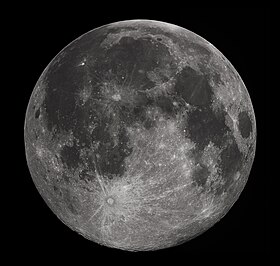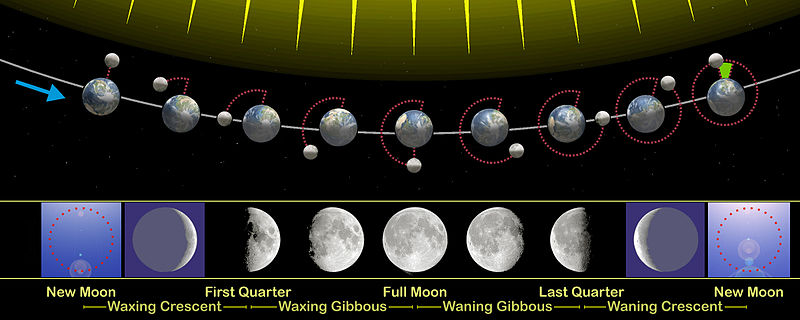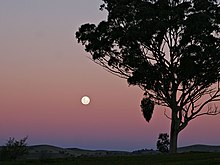
Hi Everybody!!
Tonight we have rising the Wolf Moon of January. In addition, it is also the only mini moon of this year. Before you think I have gone nuts howling at the moon, I can assure you I have Wikipedia info below on all these names for tonight's Full Moon! The moon is something we all share. Where ever you are on earth, you can look up and see the moon. Anybody can go to the moon (if you desire). Personally, I am happy to stand on the ground and look up. For those of you inside, I have brought you the moon I captured tonight. Enjoy!

just rising above tree line




Link to photostudies in albums:
https://plus.google.com/u/0/photos/117645114459863049265/albums/5969679820612011697
https://plus.google.com/u/0/photos/117645114459863049265/albums/5969523311128428705
https://en.wikipedia.org/wiki/Moon
Moon
From Wikipedia, the free encyclopedia
The Moon is the only natural satellite of the Earth[d][7] and the fifth largest moon in the Solar System. It is the largest natural satellite of a planet in the Solar System relative to the size of its primary,[e] having 27% the diameter and 60% the density of Earth, resulting in 1⁄81 its mass. Among satellites with known densities, the Moon is the second densest, after Io, a satellite of Jupiter.
The Moon is in synchronous rotation with Earth, always showing the same face with its near side marked by dark volcanic maria that fill between the bright ancient crustal highlands and the prominent impact craters. It is the brightest object in the sky after the Sun, although its surface is actually dark, with areflectance just slightly higher than that of worn asphalt. Its prominence in the sky and its regular cycle of phases have, since ancient times, made the Moon an important cultural influence on language, calendars, art and mythology. The Moon's gravitational influence produces the ocean tides and the minute lengthening of the day. The Moon's current orbital distance, about thirty times the diameter of the Earth, causes it to appear almost the same size in the sky as the Sun, allowing it to cover the Sun nearly precisely in total solar eclipses. This matching of apparent visual size is a coincidence. The Moon's linear distance from the Earth is currently increasing at a rate of 3.82±0.07 cm per year, but this rate is not constant.[8]
The Moon is thought to have formed nearly 4.5 billion years ago, not long after the Earth. Although there have been several hypotheses for its origin in the past, the current most widely accepted explanation is that the Moon formed from the debris left over after a giant impact between Earth and a Mars-sized body.
The Moon is the only celestial body other than Earth on which humans have set foot. The Soviet Union's Luna programme was the first to reach the Moon with unmanned spacecraft in 1959; the United States' NASA Apollo programachieved the only manned missions to date, beginning with the first manned lunar orbiting mission by Apollo 8 in 1968, and six manned lunar landings between 1969 and 1972, with the first being Apollo 11. These missions returned over 380 kg of lunar rocks, which have been used to develop a geological understanding of the Moon's origins, the formation of its internal structure, andits subsequent history.
After the Apollo 17 mission in 1972, the Moon has been visited only by unmanned spacecraft. Of these, orbital missions have dominated: Since 2004, Japan, China, India, the United States, and the European Space Agency have each sent lunar orbiters, which have contributed to confirming the discovery oflunar water ice in permanently shadowed craters at the poles and bound into the lunar regolith. The post-Apollo era has also seen two rover missions: the final Soviet Lunokhod mission in 1973, and China's ongoing Chang'e 3 mission, which deployed its Yutu rover on 14 December 2013.
Future manned missions to the Moon have been planned, including government as well as privately funded efforts. The Moon remains, under the Outer Space Treaty, free to all nations to explore for peaceful purposes.

Full moon as seen from Earth's northern hemisphere
| |||||||||||||
| Designations | |||||||||||||
|---|---|---|---|---|---|---|---|---|---|---|---|---|---|
| Adjective | lunar, selenic | ||||||||||||
| Orbital characteristics | |||||||||||||
| Perigee | 363,295 km (0.0024 AU) | ||||||||||||
| Apogee | 405,503 km (0.0027 AU) | ||||||||||||
| Semi-major axis | 384,399 km (0.00257 AU)[1] | ||||||||||||
| Eccentricity | 0.0549[1] | ||||||||||||
| Orbital period | 27.321582 d (27 d 7 h 43.1 min[1]) | ||||||||||||
| Synodic period | 29.530589 d (29 d 12 h 44 min 2.9 s) | ||||||||||||
| Average orbital speed | 1.022 km/s | ||||||||||||
| Inclination | 5.145° to the ecliptic[2] (between 18.29° and 28.58° to Earth's equator)[1] | ||||||||||||
| Longitude of ascending node | regressing by one revolution in 18.6 years | ||||||||||||
| Argument of perigee | progressing by one revolution in 8.85 years | ||||||||||||
| Satellite of | Earth | ||||||||||||
| Physical characteristics | |||||||||||||
| Mean radius | 1,737.10 km (0.273 Earths)[1][3] | ||||||||||||
| Equatorialradius | 1,738.14 km (0.273 Earths)[3] | ||||||||||||
| Polar radius | 1,735.97 km (0.273 Earths)[3] | ||||||||||||
| Flattening | 0.00125 | ||||||||||||
| Circumference | 10,921 km (equatorial) | ||||||||||||
| Surface area | 3.793 × 107 km2 (0.074 Earths) | ||||||||||||
| Volume | 2.1958 × 1010 km3 (0.020 Earths) | ||||||||||||
| Mass | 7.3477 × 1022 kg (0.012300 Earths[1]) | ||||||||||||
| Mean density | 3.3464 g/cm3[1] | ||||||||||||
| Equatorial surface gravity | 1.622 m/s2 (0.165 4 g) | ||||||||||||
| Escape velocity | 2.38 km/s | ||||||||||||
| Sidereal rotation period | 27.321582 d (synchronous) | ||||||||||||
| Equatorial rotation velocity | 4.627 m/s | ||||||||||||
| Axial tilt | 1.5424° (to ecliptic) 6.687° (to orbit plane)[2] | ||||||||||||
| Albedo | 0.136[4] | ||||||||||||
| |||||||||||||
| Apparent magnitude | −2.5 to −12.9[a] −12.74 (mean full moon)[3] | ||||||||||||
| Angular diameter | 29.3 to 34.1 arcminutes[3][b] | ||||||||||||
| Atmosphere[6] | |||||||||||||
| Surfacepressure | 10−7 Pa (day) 10−10 Pa (night)[c] | ||||||||||||
| Composition | Ar, He, Na, K, H, Rn | ||||||||||||
Appearance from Earth
See also: Lunar phase, Earthshine, and Observing the Moon
The Moon is in synchronous rotation: it rotates about its axis in about the same time it takes to orbit the Earth. This results in it nearly always keeping the same face turned towards the Earth. The Moon used to rotate at a faster rate, but early in its history, its rotation slowed and became tidally locked in this orientation as a result of frictional effects associated with tidal deformations caused by the Earth.[98] The side of the Moon that faces Earth is called thenear side, and the opposite side the far side. The far side is often called the "dark side", but in fact, it is illuminated as often as the near side: once per lunar day, during the new moon phase we observe on Earth when the near side is dark.[99]
The Moon has an exceptionally low albedo, giving it a reflectance that is slightly brighter than that of worn asphalt. Despite this, it is the second brightest object in the sky after the Sun.[50][i] This is partly due to the brightness enhancement of the opposition effect; at quarter phase, the Moon is only one-tenth as bright, rather than half as bright, as at full moon.[100]
Additionally, colour constancy in the visual system recalibrates the relations between the colours of an object and its surroundings, and since the surrounding sky is comparatively dark, the sunlit Moon is perceived as a bright object. The edges of the full moon seem as bright as the centre, with no limb darkening, due to the reflective properties of lunar soil, which reflects more light back towards the Sun than in other directions. The Moon does appear larger when close to the horizon, but this is a purely psychological effect, known as the Moon illusion, first described in the 7th century BC.[101] The full moon subtends an arc of about 0.52° (on average) in the sky, roughly the same apparent size as the Sun (see eclipses).
The monthly changes of angle between the direction of illumination by the Sun and viewing from Earth, and the phases of the Moon that result
The highest altitude of the Moon in the sky varies: while it has nearly the same limit as the Sun, it alters with the lunar phase and with the season of the year, with the full moon highest during winter. The 18.6-year nodes cycle also has an influence: when theascending node of the lunar orbit is in the vernal equinox, the lunar declination can go as far as 28° each month. This means the Moon can go overhead at latitudes up to 28° from the equator, instead of only 18°. The orientation of the Moon's crescent also depends on the latitude of the observation site: close to the equator, an observer can see a smile-shaped crescent Moon.[102]
The distance between the Moon and the Earth varies from around 356,400 km to 406,700 km at the extreme perigees (closest) and apogees (farthest). On 19 March 2011, it was closer to the Earth while at full phase than it has been since 1993.[103] Reported as a "super moon", this closest point coincides within an hour of a full moon, and it thus appeared 30 percent brighter, and 14 percent larger in diameter than when at its greatest distance.[104][105][106]
There has been historical controversy over whether features on the Moon's surface change over time. Today, many of these claims are thought to be illusory, resulting from observation under different lighting conditions, poor astronomical seeing, or inadequate drawings. However, outgassing does occasionally occur, and could be responsible for a minor percentage of the reported lunar transient phenomena. Recently, it has been suggested that a roughly 3 km diameter region of the lunar surface was modified by a gas release event about a million years ago.[107][108] The Moon's appearance, like that of the Sun, can be affected by Earth's atmosphere: common effects are a 22° halo ring formed when the Moon's light is refracted through the ice crystals of high cirrostratuscloud, and smaller coronal rings when the Moon is seen through thin clouds.[109]
From Google Search:
'Mini Moon' 2014: Here's Why Lunar Disk Looks So Small In Mid ...
www.huffingtonpost.com/2014/01/.../mini-moon-2014_n_4609248.htm...
- 2 hours ago - The smallest full moon of 2014 rises in the night sky tonight (Jan. 15), and there's some interesting science behind the lunar sight. Two years ...
Full Moon Names and Their Meanings | Farmers' Almanac
- www.farmersalmanac.com/full-moon-names/
Full Wolf Moon – January Amid the cold and deep snows of midwinter, the wolf packs howled hungrily outside Indian villages. Thus, the name for January's full ...
Full moon
A full moon is the lunar phase that occurs when the Moon is completely illuminated as seen from the Earth. This occurs when the Moon is in opposition with the Sun (when it is on the opposite side of the Earth from the Sun; more precisely, when the ecliptic longitudes of the Sun and Moon differ by 180 degrees).[1] This means that the hemisphere of the Moon that is facing the Earth (the near side) is almost fully illuminated by the Sun and appears round (while the far side is almost completely unilluminated).
Lunar eclipses can occur only at full moon, where the moon's orbit allows it to pass through the Earth's shadow. Lunar eclipses do not occur every month because the moon usually passes above or below the Earth's shadow (which is mostly restricted to the ecliptic plane). Lunar eclipses can occur only when the full moon occurs near the two nodes of the orbit, either the ascending or descending node. This causes eclipses to only occur about every 6 months, and often 2 weeks before or after a solar eclipse at new moon at the opposite node.
The time interval between similar lunar phases—the synodic month—averages about 29.53 days. Therefore, in those lunar calendars in which each month begins on the new moon, the full moon falls on either the 14th or 15th of the lunar month. Because calendar months have a whole number of days, lunar months may be either 29 or 30 days long.
In folklore and tradition[edit]
See also: List of lunar deities and Lunar effect
Full moons are traditionally associated with temporal insomnia, insanity (hence the termslunacy and lunatic) and various "magical phenomena" such as lycanthropy. Psychologists, however, have found that there is no strong evidence for effects on human behavior around the time of a full moon.[5] They find that studies are generally not consistent, with some showing a positive effect and others showing a negative effect. In one instance, the 23 December 2000 issue of the British Medical Journal published two studies on dog bite admission to hospitals in England and Australia. The study of the Bradford Royal Infirmaryfound that dog bites were twice as common during a full moon, whereas the study conducted by the public hospitals in Australia found that they were less likely.
Full moon names[edit]
Historically, month names are names of moons (lunations, not necessarily full moons) inlunisolar calendars. Since the introduction of the solar Julian calendar in the Roman Empire, and later the Gregorian calendar worldwide, month names have ceased to be perceived as "moon names". The traditional Old English month names were equated with the names of the Julian calendar from an early time (soon after Christianization, according to the testimony of Bede ca. AD 700).
Some full moons have developed new names in modern times, e.g. the blue moon, and the names "harvest moon" and "hunter's moon" for the full moons of autumn.
Farmers' Almanacs[edit]
The Maine Farmers' Almanac from c. the 1930s began to publish "Indian" full moon names. The Farmers' Almanac (since 1955 published in Maine, but not the same publication as the Maine Farmers' Almanac) continues to do so.[12]
An early list of "Indian month names" was published in 1918 by Daniel Carter Beard in his The American Boy's Book of Signs, Signals and Symbols for use by the boy scouts. Beard's "Indian" month names were:
- January: Difficulty, Black Smoke; February: Racoon, Bare Spots on the Ground; March: Wind, Little Grass, Sore-Eye; April: Ducks, Goose-Eggs; May: Green Grass, Root-Food; June: Corn-Planting, Strawberry; July: Buffalo (Bull), Hot Sun; August: Harvest, Cow Buffalo; September: Wild Rice, Red Plum; October: Leaf-Falling, Nuts; November: Deer-Mating, Fur-Pelts, December: Wolves, Big Moon.[13]
Such names have gained currency in American folklore. They appear in print more widely outside of the almanac tradition from the 1990s in popular publications about the Moon. Mysteries of the Moon by Patricia Haddock ("Great Mysteries Series", Greenhaven Press, 1992) gave an extensive list of such names along with the individual tribal groups they were supposedly associated with.[14]Haddock supposes that certain "Colonial American" moon names were adopted from Algonquian languages (which were formerly spoken in the territory of New England), while others are based in European tradition (e.g. the Colonial American names for the May moon, "Milk Moon", "Mother's Moon", "Hare Moon" have no parallels in the supposed native names, while the name of November, "Beaver Moon" is supposedly based in the Algonquin).
The individual names given in Farmers' Almanac include:[clarification needed]
- January: "Wolf Moon" (this is the name of December in Beard 1918)[15] also "Old Moon"
- February: "Snow Moon", also "Hunger Moon"
- March: "Worm Moon", "Crow Moon", "Sap Moon", "Lenten Moon"
- April: "Seed Moon", "Pink Moon", "Sprouting Grass Moon", "Egg Moon" (c.f. "Goose-Egg" in Beard 1918), "Fish Moon"
- May: "Milk Moon", "Flower Moon", "Corn Planting Moon"
- June: "Mead Moon", "Strawberry Moon" (c.f. Beard 1918), "Rose Moon", "Thunder Moon"
- July: "Hay Moon", "Buck Moon", "Thunder Moon"
- August: "Corn Moon", "Sturgeon Moon", "Red Moon", "Green Corn Moon", "Grain Moon"
- September: "Harvest Moon", "Full Corn Moon",
- October: "Hunter's Moon", "Blood Moon"/"Sanguine Moon"
- November: "Beaver Moon", "Frosty Moon"
- December: "Oak Moon", "Cold Moon", "Long Nights Moon"





link to King Buzz album:
https://plus.google.com/u/0/photos/117645114459863049265/albums/5968403854244598161






...this is brendasue signing off from Rainbow Creek. See You next time!



O+O





No comments:
Post a Comment
Hi Everybody! Please say hello and follow so I know you are here! Due to the inconsideration of people trying to put commercials on my blog comment area, I have restricted use of anonymous posts. Sorry that some hurt all.
My public email is katescabin@gmail.com No spammers or trolls